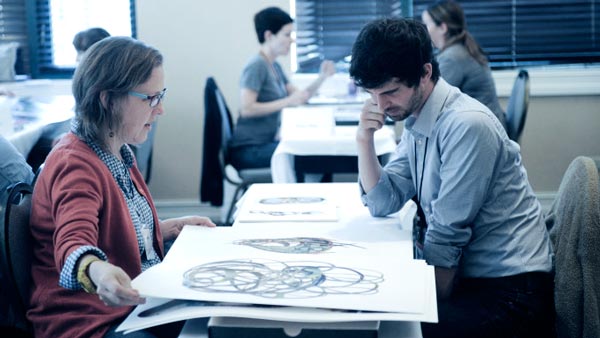Each spring, I visit art schools in the northeast and present about CloudKid, our work, and my career path from art school student to entrepreneur. After I finish my spiel, students and professors always ask, “How did you learn how to start and run a business?” I always give the same answer, “It’s kind of like playing the Legend of Zelda.” People laugh but I’m 100% serious. There are valuable business lessons that students, artists, and young entrepreneurs can learn from Link, the pointy-eared hero. Without further ado, I present The Legend of Zelda Guide to Startups.
1) Talk with the Old Man (or Woman)

When Link is lost or needs some direction, he seeks out townspeople or merchants who provide valuable information and help him make sense of the world. Sometimes, they even point him toward someone or something to support his mission. Link talks with the Old Man in the cave who tells him to visit a merchant under a waterfall. Then he treks all the way across Hyrule to get the next piece of helpful (and sometimes crucial) information. In the early days, I talked with people who knew more about everything than I did—budgeting, accounting, hiring, renting space, insurance, contracts, producing projects, etc. I asked family, friends, friends of friends, ex-colleagues, and sometimes strangers…It also helps that my twin brother works in VC. This expert info was invaluable because it helped me understand things outside of my comfort zone and spared me from wandering aimlessly in uncharted territories.
2) Add to Your Arsenal

Link is only as strong as as the tools he has to work with. Early on, he is given the Wooden Sword and that transforms him from a boy into a warrior. Throughout his adventure, Link acquires tools and skills such as the Bow, Stepladder, Raft, Magical Key,Silver Arrow, and Book of Magic—they enable him to navigate more freely, see in the dark, kill bigger enemies, take more damage, etc. These items are a company’s employees. It was impossible for me to have every skill needed to start a business and produce projects so the first thing I did was expand my “tools” by finding a tech co-founder, hiring an animation director, and working with people who had different and more specialized skills than I did. Even a few years in we’re still expanding our arsenal—just last week we hired a HR Specialist. By upgrading the team with new expertise, it enables CloudKid to be more efficient, adaptable and intelligent. Most importantly, we can fight bigger enemies.
3) Keep your Eye on the Triforce

Link travels around Hyrule battling enemies, solving puzzles, exploring dungeons, and defeating guardian monsters, but his mission revolves around one thing—saving Princess Zelda. In order to do that, he must complete the Triforce of Wisdom by collecting all eight pieces to be powerful enough to defeat Ganon. Princess Zelda is a company’s vision while each dungeon/guardian monster that you defeat and piece of Triforce earned is a launched product, a new feature, or a completed client project. Early on, projects such as Fizzy’s Lunch Lab and Negative Nimbus were little victories that fit into our longterm vision of building transmedia brands, but we haven’t been totally immune to distractions. Internal projects such as Emogo and 3D-Play didn’t quite reinforce our mission and goals (although they were inspiring and creatively fulfilling). Luckily, we were able to refocus our sights on a new piece of Triforce and the next guardian monster that we needed slay.
4) It’s All About the Rupees Baby

Throughout his adventure, Link needs items such as arrows, bombs, potions, and food for survival, but he also needs Rupees to purchase them. While Rupees are abundant throughout Hyrule, it takes hard work to earn them—Link must put his own butt on the line and slay lots of baddies! If Link has ample Rupees, he can stock up on items that will come in handy during long dungeon missions, but if he doesn’t, his inventory will be depleted and survival will not be easy. While it is possible to prevail without money, having it undoubtedly provides an advantage. By having cash to invest in everything from product features to employees to computers/software to office space to insurance, companies are able to attain their goals more efficiently. We are fortunate to have loyal clients who have enabled us to build a studio and awesome team, but it comes at a cost. At our size we need a constant flow of projects (and cash) to keep the lights on and people employed. Sometimes this endeavor becomes all-consuming. One must be careful because the pursuit of cash can take your eye off the mission, but without it, the road will always be more difficult.
5) Don’t Let Enemies Kill You

Hyrule is a dangerous place, so it’s only natural that Link runs into nasty critters who slow him down. These obstacles are everywhere and Link must face them head on in order to survive, but it’s also inevitable that he goes unscathed. From simple nuances such as the Red Octorok to the downright pesky Wizzrobe, it’s important that Link learns how to defeat enemies, adapt, and have the right tools to do so. In a company, enemies are unforeseen obstacles and distractions such as server and network issues, an ineffective employee, a leak in the ceiling, late client payments, etc. They are inevitable and we have definitely felt their wrath, but when they have surfaced, we’ve been proactive in identifying the cause and creating solutions (to the best of our ability) so they don’t happen again. It’s important to recognize “enemies”, address them and adapt quickly. If not, they can kill you.
6) Be a Good Guy

Link’s adventure begins when he decides to rescue Princess Zelda. Humble but brave, he puts himself in harm’s way to save Hyrule and make his world a better place—he’s the ultimate “good guy” and hero. Businesses and entrepreneurs also need heart and humility. With an endless and dizzying stream of new gadgets, games, apps, sites, features, and videos launched daily, it’s more important than ever to provide something meaningful beyond your latest product and contribute to the greater good. This might include fostering a supportive work environment for employees, regularly contributing to open source projects, taking part in local community service, or building technology that reverses climate change. In addition to the educational media that we produce, we try and give back via our production tools such as Keyframe Caddy and PixiParticles, and contribute to the Github community. These efforts aren’t about boosting our bottom line, but rather supporting the larger creative community to make better stuff. We’re all in this fight together, and sometimes one little hero can change the world.














